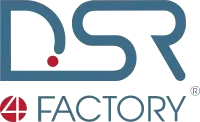ERP system in a manufacturing company – what should you know before you decide on it?
19 March 2022
It is hard to imagine that today’s company would function without an integrated enterprise management system called Enterprise Resources Planning – ERP. In the era of globalization, companies have access to modern technologies, information systems, cheap materials – most raw materials are produced in countries where labour costs are still low, so to remain competitive, companies need to reorganize. The ideal way to organize and standardize processes is to implement an ERP class system in a manufacturing company. The rapid growth of businesses that has occurred in recent years in Poland has forced manufacturing companies to change the way they manage. A company with 20 employees and a small warehouse is managed in a different way than a plant with 500 employees and external warehouses. In the growth phase, companies cope in various ways, e.g.: with applications and small support systems available on the market. However, at some point, everyone recognizes that this is not the way and a decision is made to implement an integrated ERP production management system.
After many negotiations and meetings, it is finally here – the only one chosen. At this stage, expectations as to the results of the implementation of the new system are very different. The company’s management believes that after launching the production management program; as if by magic everything will fall into place, the employees will perform their tasks smoothly, and the ERP system for production through its functionality will significantly reduce costs. An ordinary worker, on the other hand, simply fears for his workplace. He sees all the confusion in the company as a threat to himself and his workplace.
The implementation process begins – and as always, there is chaos at the beginning
The first stage is a review of the company’s current processes. It is here that the management often learns, often to their surprise, how the company really functions. It turns out that people responsible for particular areas of activity, in the absence of standards; create their own procedures and ways. These ways are not bad – they are created so that the company could operate and individual teams could perform their tasks. However, the lack of systematization causes that these internal procedures are often different, even sometimes contradictory. The reason for this situation is usually the lack of communication between these teams, caused by the need for rapid organization and a multitude of tasks. Implementation of an ERP system, especially for the production area, forces a kind of “round table”, causes that these teams begin to talk to each other and establish common procedures and standards, which can then be mapped in the system. Not infrequently, in conflict situations, it is the management that is forced to decide and judge how a given process should look in the new, post-implementation world. As a result, all key and less key processes are discussed, debated and agreed upon. New standards are created in the company, which through their mapping in ERP are maintained. The system, through the construction of transactions, forces the users to work in certain, always the same way. This also causes that a single employee loses his “irreplaceable” status. All people responsible for a given area do the same thing in the same way – a momentary absence of Mr Jan will not stop production – he will be replaced by Ms Ola who knows very well what and how to do it at a given moment. Employees gain a kind of freedom – vacation is no longer dependent on the rhythm of production, and any illness will not cause an earthquake in the company or the need to work remotely from bed. ERP system for production forces discipline and standardization of work.
It is time for data…
The correctness of master data is crucial to the functioning of any system. An ERP system for manufacturing companies is based on indexes, BOMs (recipes), technologies or chart of accounts. The master data is a huge area that needs to be sorted out before running the system. In a changing economic environment, with large production changes and continuous modifications, the data must be updated on an ongoing basis. Such activities result in inactive codes, many BOMs must be modified, and technological times change … Implementation of a production management system in the company forces order. It forces to look at the data, to organize and complete them. In some cases, it forces a change – a new concept of data management and a new information flow. Data warehouses are often created, which are then used to create reports for the company’s board and management. The verified, structured data is then imported into the system and the testing phase begins. In this phase, designated user groups simulate the processes occurring in the company with the use of already arranged data. All stages of material flow are tested – from receipt into the warehouse, through releasing to production, to shipping to the customer. The software and the planning of material requirements – production in stock and on order – are checked. Quality control management. Warehouse management. Production order management. Turnover of production and discontinued materials. Returns from customers and returns to suppliers. Complaints. Raw material utilization and machine occupancy in production. Packaging management – in-house, customer and supplier. ERP in manufacturing is a very important element. Increasingly important for customers is the maintenance service (SUR). Management and turnover of spare parts for machines, planning of machine inspections and automation in reporting failures are more and more desirable features of modern ERP system for production management. They allow minimizing downtime caused by failures or lack of spare parts. The ability to handle service requests via a tablet or smartphone accelerates the response time in case of a machine failure. Recording such events in the system allows you to later analyse the data and draw conclusions – and thus, changes in the organization leading to improvements. Another desirable functionality of the ERP system is its ability to communicate with other systems – through specialized EDI platforms, webEDI or simple ftp. More and more companies are moving to electronic communication – orders, forecasts, and shipment confirmations are sent as special messages. These messages are then imported into the ERP class system and form the basis for planning shipments to the customer and production. ERP systems for production allow for accurate and fast planning of production orders – exactly according to customer needs. Based on these orders, raw material requirements are then generated. Purchase orders and raw material delivery plans can also be sent to suppliers electronically. Today’s ERPs also “talk” to banks, tax, statistical and customs offices. Speaking of ERPs, we must not forget about finance. The production activity of a company is inextricably linked with the flow of financial assets. Every company is obliged to pay salaries to its employees and settle accounts with the tax authorities. It must pay its suppliers of goods and services, as well as settle the receipts for deliveries to customers. Here again with help comes the ERP class system. All processes and transactions defined in the system, being a reflection of real processes in the company, find their finale in the financial department. On the correct mapping of transactions and accuracy of data entered depends the reliability of financial results. Costs and profits will be as accurate as accurately defined all stages of the company’s activity leading to their creation. The board of directors is primarily interested in the financial results, profits and costs. The management of a company needs to know if and how much it earns while running its business. It is equally interested in the accuracy and timeliness of settlements with employees, suppliers and customers, as well as with the broader tax authorities. One more very important function of ERP is the ability to manage user permissions. It is not always desirable for a warehouse employee to have access to financial data. User permissions to specific data areas or specific transactions and sets of transactions serve to limit these accesses. We can define all these rules in ERP.
Data organized, system tested…
ERP system for manufacturing – day of launch in the company
Regardless of the level of preparation of the system, readiness of users, the period of launching a new system is always associated with confusion in the company. The need to use a new interface, different information flow, change of processes and transactions is always noticeable in the first days. However, the situation stabilizes quickly. Users become more and more familiar with the system, transactions are tested in real time, and any corrections are implemented on an ongoing basis. The main benefit of implementing an integrated system to manage the company is, first, raising it to a higher organizational level. One, standardized database and unified reporting system allow for easy and simple access to information and facilitate taking right decisions. However, there are other, more tangible benefits as well.
Current data entry, management and settlement of production on-line gives a better, reliable and accurate information for managers of supplies and shipments and significantly reduces the time from problem occurrence to its identification. This in turn affects the stability of raw material supply, and thus reduces inventory levels and significantly reduces the costs associated with additional, unplanned transports. ERP software for manufacturing allows for greater transparency of transactions and their easy control. Picking takes place more efficiently, and the timeliness of shipments to customers increases – which in turn affects customer satisfaction and the acquisition of new markets. Information transparency increases the use of production resources and work efficiency. Work stoppages caused by lack of raw materials are reduced and there is no need to change the production plan “at the last minute”. In addition, packaging management works flawlessly – there are no stoppages or changes in the production plan due to lack of containers. The introduction of ERP in SUR eliminates long-term machine breakdowns; current faults are taken care of almost immediately. Automation of accounting processes streamlines work in the finance department. Communication with external entities runs smoothly, documents are sent on time and in the right format. In the end, the company gains much better financial liquidity and tangible benefits such as elimination of additional transports, increased production efficiency and increased number of customers, and the serial employee no longer has to put out fires – he can take care of his duties.
Author:
Iwona Nalepa
Senior Consultant








